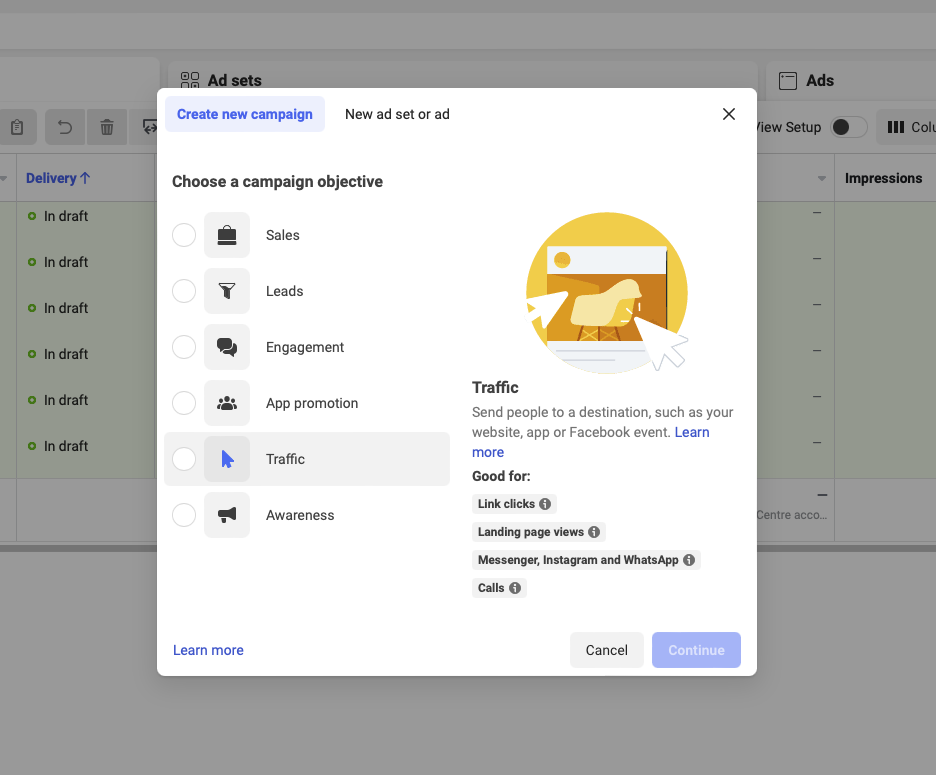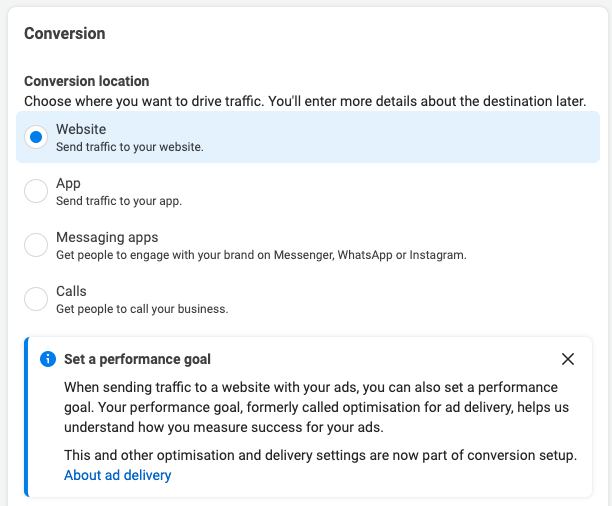Although Facebook is the top platform for building brand awareness, it is also a great way to get people to your website. If you want to increase the traffic on your blog, send people to your online shop, or listen to your latest track, the traffic objective might entice you.
We’ve already covered the brand awareness and engagement objectives on our blog, but this time let’s dive into how to use Facebook ads to increase your website traffic.

What is the traffic objective for?
Facebook’s traffic objective is used to “send people to a destination, such as your website or an app.” With this objective, you can create ads that drive users to a desired location, and key performance indicators (KPIs) such as cost-per-click (CPC), click-through rate (CTR), and cost per landing page view (CPLPV) help track the success of your campaign.
When should you use the traffic objective?
The traffic objective is suitable for various scenarios. For example, if you have a podcast or blog and want to increase traffic, or if you’re an online store aiming to generate interest and awareness for your products. In these cases, the traffic objective can help you achieve your goals effectively.
Can the traffic objective help generate leads?
It’s not that straightforward.
While the traffic objective can increase traffic and drive visitors to your landing pages and sign-up forms, it may not necessarily help your Facebook ad reach individuals who are likely to convert or make a purchase. The objective optimizes your campaign for clicks, not conversions.
If you choose the traffic objective, Facebook will show your ad to people who are most likely to click on external links. That means that Facebook won’t necessarily target people who are looking to buy something or learn from a webinar.
So why would you use it then, you might ask? Despite its limitations, the traffic objective serves several valuable purposes:
Use the traffic objective when you’re just starting to build your audiences to build the foundation for your future conversion campaigns
If you set up a conversion campaign without having at least some knowledge of what kind of audience would be interested in your products, the results will not be satisfying. This is because you simply don’t have enough data to work with.
In this case, beginning with the traffic campaign is a great way to attract people who might be interested in your product and turn them into a custom audience that you can later target in your conversion campaigns.
When you can’t track conversions
If you’re selling products on sites that you don’t own, such as Amazon, E-bay, or Etsy, or you want to send people to listen to your latest track on Spotify, using the traffic objective makes more sense than the conversion objective.
This is because you can’t install Facebook pixel on these sites, so you can’t track conversions. If you can’t track conversions on your site, it doesn’t make sense to run conversion campaigns, which are also much more expensive.
This also applies to scenarios when you cannot install a Facebook pixel on your site for any reason.
When you just want people to read your article, and you don’t want to convert them
If you’re running Facebook ads simply to get clicks on your blog posts and you’re not trying to sell anything or have people sign up for your newsletter, you can safely stick with the traffic objective.
Why do advertisers dislike traffic campaigns?
It’s kind of a general consensus among Facebook advertisers to stay clear of the traffic campaigns because, for most people advertising on Facebook, conversions are the goal, not traffic. So why would you waste your time using the traffic objective, targeting people who are not necessarily looking to buy from you?
Even though your advertising costs to drive traffic to your website will be lower when you’re using the traffic objective versus the conversion objective, this is only because the audience for the traffic goal is much larger. But much less likely to convert.
Ben Heath of Heath Media shares his only two reasons to use the traffic objective in this video and explains this in greater detail.
Conclusion
The purpose of the traffic objective is to generate website traffic. It is used to optimize your campaign for link clicks and landing page views. While at first glance it might make sense to follow the sales funnel and use the traffic objective as a way to generate traffic and leads, sometimes it’s just better to skip right to the conversions objective.
If, for some reason, you can’t track conversions, use the traffic objective to get people where you want them. If you’re just looking to get more clicks on your website content, use the traffic objective. But if you’re looking to convert your audience and you have a Facebook pixel installed on your website, the conversion objective is a better option.


